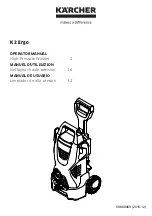
Cod. G522433
© Copyright 2009, Alliance Laundry System LLC – DO NOT COPY OR TRANSMIT Rev. 00/0510
Installation
19
TILT MODELS
After the starting-up of the washer, check that the loading and unloading movements don't no move
the drain outlet hose out of the sewer drain box.
In installation with the connection directly to the sewer, the connections of both ends of the drain
hose must be fastened.
3.2. Water
inlets
Hoses and pipes should be flushed through before being connected to the machine.
Install at each water supply and in an accessible location, a mechanically interlocked water valve.
Refer to technical specifications on the INSTALLATION SPECS, section
1.4.
IMPORTANT!
SIPHONAGE CONTAMINATION PREVENTION
If the washer extractor is directly connected to the water supply, an antisiphon device and a
supplement filter must be connected either to the external supply inlet or prior to every connection.
Follow the local and national regulations concerning the water supply system.
IMPORTANT!
PROTECTION AGAINST OVER-PRESSURES
IF THE SUPPLY PRESSURE IS HIGH AND FLUID HAMMERS OCCUR WHEN CLOSING THE VALVES,
WE RECOMMEND INSTALLING A SMALL AIR VESSEL OR ANTI-FLUID-HAMMER DEVICE TO
PREVENT PREMATURE DAMAGE TO MEMBRANES.
Assembling the filters and their connection
(fig.14)
Directly assemble the supplied filters to the machine water inlets. Assure they are watertight by means of a
suitable product. The arrow of the filter shows the direction of water flow. Connect the hoses to the filters. Do
not forget the seals.
Arrangement of hoses
Inlets are identified by labels posted at each inlet (fig. 15).
The washer mixes hot and cold water according to the
programmed temperature. The use of cold/hot water allows the
machine to gain time and effectiveness in its washing
programmes.
Inlet 1
.
Connect cold water.
Inlet 2
.
Connect hot water.
Inlet 3
.
Connect cold or hot water according to the
washer configuration.
TILT MODELS
The location of the water supply must allow that hoses accommodate the washer's movements
during loading and unloading operations. Refer to section 4.5.
fig 14
















































